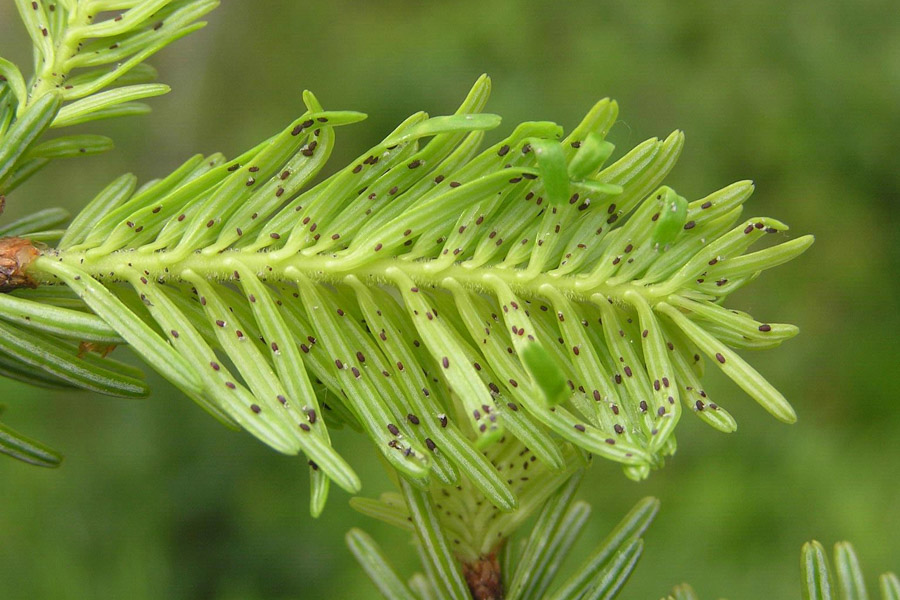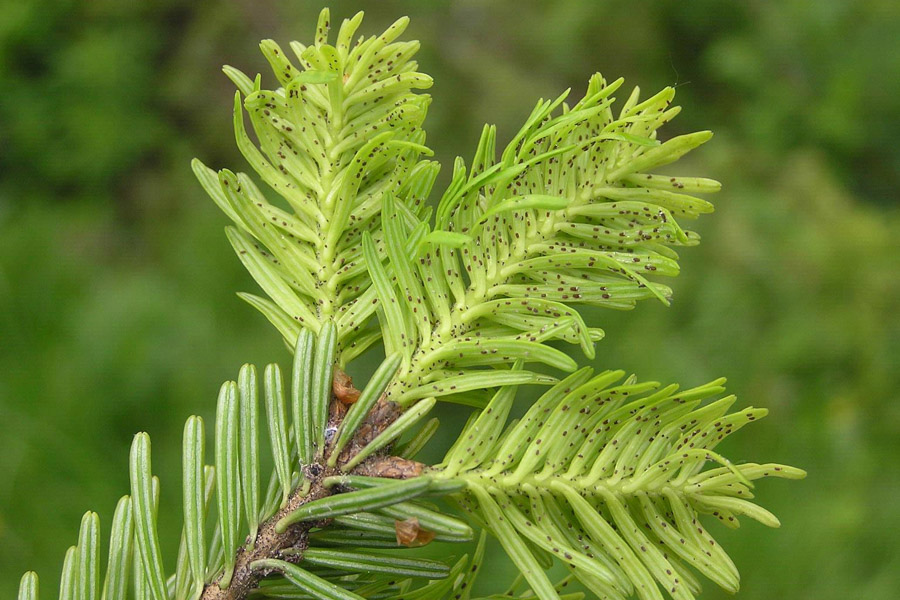Dreyfusia nordmannianae (silver fir adelges)
Identity
- Preferred Scientific Name
- Dreyfusia nordmannianae (Eckstein, 1890)
- Preferred Common Name
- silver fir adelges
- Other Scientific Names
- Adelges (Dreyfusia) nordmannianae (Eckstein, 1890)
- Adelges nordmannianae (Eckstein, 1890)
- Adelges nüsslini (Börner)
- Adelges nüsslini Annand, 1928
- Chermes nordmannianae Eckstein, 1890
- Chermes nüsslini (Börner)
- Dreyfusia funitecta
- Dreyfusia nüsslini Börner, 1908
- Dreyfusia schneideri
- International Common Names
- Englishmigratory adelges of silver firsilver fir migratory adelgessilver fir woolly aphid
- Frenchchermès des rameauxchermès du sapin
- Local Common Names
- Denmarkalmindelig ædelgranlus
- Finlandjalokuusikirva
- GermanyStammlaus, Nordmannstannen-TannentrieblausTannentrieblaus, Einbruetige
- NetherlandsZilversparwolluis
- EPPO code
- DREYNU (Dreyfusia nuesslini)
Pictures

Infestation
Dreyfusia nordmannianae (silver fir adelges); Crawlers on the basal side of the needles. Slovakia. August 2008.
©Milan Zubrik, Forest Research Institute - Slovakia/via Bugwood.org - CC BY-NC 3.0

Infestation
Dreyfusia nordmannianae (silver fir adelges); Crawlers on the basal side of the needles. Slovakia. August 2008.
©Milan Zubrik, Forest Research Institute - Slovakia/via Bugwood.org - CC BY-NC 3.0

Symptom
Dreyfusia nordmannianae (silver fir adelges); Shortening of the young branches. Slovakia. August 2008.
©Milan Zubrik, Forest Research Institute - Slovakia/via Bugwood.org - CC BY-NC 3.0
Distribution
Host Plants and Other Plants Affected
| Host | Host status | References |
|---|---|---|
| Abies alba (silver fir) | Other | Kollár (2007) |
| Abies cilicica (cilician fir) | Other | |
| Abies nordmanniana (Nordmann fir) | Other | |
| Picea orientalis (oriental spruce) | Main |
List of Symptoms/Signs
| Symptom or sign | Life stages | Sign or diagnosis |
|---|---|---|
| Plants/Growing point/distortion | ||
| Plants/Leaves/abnormal colours | ||
| Plants/Leaves/abnormal forms | ||
| Plants/Leaves/abnormal leaf fall | ||
| Plants/Leaves/leaves rolled or folded | ||
| Plants/Stems/dieback | ||
| Plants/Stems/distortion | ||
| Plants/Stems/galls | ||
| Plants/Stems/witches broom | ||
| Plants/Whole plant/discoloration | ||
| Plants/Whole plant/external feeding |
Prevention and Control
Cultural Control and Sanitary Measures
Cutting and burning (on site) of severely-attacked trees during the winter is a cultural control measure used in forested areas where no chemicals are used. Firs should be propagated and grown underneath a slightly thinned mature stand or mixed with young alder or European rowan (Nierhaus-Wunderwald and Forster, 1999). Firs with little damage to the top shoots should be spared as resistance to D. nordmannianae will increase with age.
Movement Control
Do not pull uprooted trees heavily infested with D. nordmannianae through a plantation; the aphids could spread to healthy firs by contact.
Biological Control
Some options proposed by Kenis et al. (2007) include a chamaemyiid fly, Leucopis sp., some dipterans from the Syrphidae and Cecidomyiidae families and coleopterans from the families Coccinellidae and Derodontidae. Ravn et al. (2013) found L. hennigrata to be the most promising biological agent. L. hennigrapta appears to be an important naturally-occuring predator of D. nordmannianae in Turkey and possibly the Caucasus. Small populations of D. nordmannianae in Turkey seemed to correlate with high levels of predation by L. hennigrapta
Chemical Control
Chemical control is used in Christmas tree plantations and might be necessary during the growing season to protect the trees from 'bottle brush' deformation. Compounds used include synthetic pyrethroids, nicotinoids, organophosphates and carbamates (Demolis et al., 1991, 1999; Palmer, 2009).
Host Resistance (incl. vaccination)
Ongoing breeding and research in quantitative genetics of Nordmann fir Christmas trees are taking place in Denmark, and results indicate substantial economic gains (Nielsen and Hansen, 2000). Natural resistance had been observed in the past in Abies nordmanniana and Abies alba by Varty (1956), Løfting (1973), Larsen et al.(1984) and others. Natural resistance was then confirmed by Kirkeby-Thomsen (1998). Since then some molecular projects have been initiated such as the development of microsatellite markers in A. nordmanniana (Hansen et al., 2005). The breeding programme uses clonal seed orchards (CSOs) and testing of open-pollinated families (half-sib families) (Hansen and Kjær, 2006).
Impact
Nordmann fir (Abies nordmanniana) is the main tree species for Christmas tree production in many Northern European countries and adelgid attack is a severe problem that causes important losses in plantations (Jacobsen, 1988; Larsen et al., 1997).
Information & Authors
Information
Published In
Copyright
Copyright © CABI. CABI is a registered EU trademark. This article is published under a Attribution-NonCommercial-NoDerivatives 4.0 International (CC BY-NC-ND 4.0)
History
Published online: 4 October 2022
Language
English
Authors
Metrics & Citations
Metrics
SCITE_
Citations
Export citation
Select the format you want to export the citations of this publication.
EXPORT CITATIONSExport Citation
View Options
View options
Get Access
Login Options
Check if you access through your login credentials or your institution to get full access on this article.


